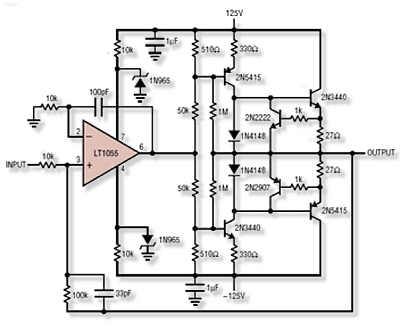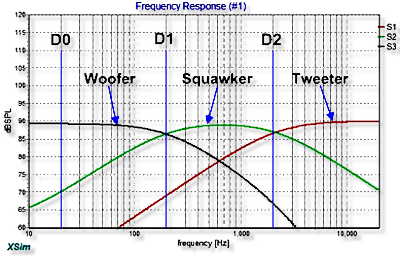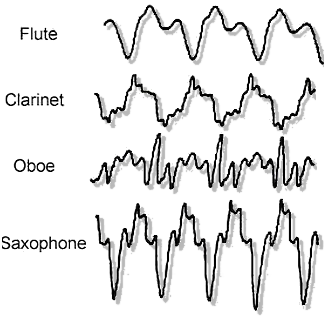 Contact
Home
Chapters
Contact
Home
Chapters
What You Are Hearing

Audio is unique in that it occupies the Electromagnetic space of electronic signals, the Mechanical space of transducers and the Tympanic space of sound pressure that we hear.
Most of us have heard the often cited range of audio as 20hz to 20,000hz. But for the most part we don't really know what that means or why it matters. For most it's just an expected range of numbers when discussing speakers and amplifiers.
It is surprising to notice how many people don't actually know what these tones actually sound like. There is a tendency to estimate pitch either way too high or way too low, largely because they've never actually heard these sounds as distinct entities or ranges.
But, if you want to set up a good quality system, you really do need to be able to judge what ranges of sound need to be tweaked when positioning speakers or setting an EQ curve in your amplifiers. Even a very general familiarity can help you achieve far better results and might save you some money on mistaken purchases.
So lets explore and learn what various parts of the audio spectrum actually sound like...
Some of these tones can be piercing, so keep your volume to a low-comfortable level.)
Frequency and wavelength Home Top Chapters
Sound travels in waves. Every wave has two basic properties; Frequency and Wavelength.Frequency is a measure of how often something happens in a given time period. In our case we are concerned about how many times per second a sound wave completes one full cycle of pressurizing and rarifying the air. This is commonly marked as "HZ" or "Hertz" but can also be cited as "CPS" or "Cycles Per Second". For our purposes we are concerned about the range from 20hz to 20,000hz.
Sound travels at a more or less fixed speed so as the frequency increases, the distance occupied by one wave of that frequency decreases. Audio wavelengths run from 17.5 metres at 20hz to 1.7 centimetres at 20,000hz.
A handy calculator for converting between audio frequencies and wavelengths is on Translator's Cafe.
Full range sound Home Top Chapters
In audio terms "Full Range" means that something can use the full 20 to 20khz range of audio frequencies. This is highly desirable in our electronics so that every sound in the audio spectrum is amplified and faithfully reproduced for us.To hear what the full audio range sounds like, click the button below.
Don't worry if you don't hear sound at the beginning or end of the sweep. Most people do not hear the full 20 to 20,000 range. At conversational levels average hearing runs from about 50hz to 13,000hz but falls off rapidly outside that range. Also, some speakers (even the expensive ones) cannot reproduce the full audio range.
Audio for electronics Home Top Chapters
 Our electronics need to cover the entire range of human hearing, preferably with some space to spare. It is not uncommon for modern audio equipment to cover a range from 3 or 4hz all the way to 30,000hz or more. This is to ensure best performance within the standard 20-20k range.
Our electronics need to cover the entire range of human hearing, preferably with some space to spare. It is not uncommon for modern audio equipment to cover a range from 3 or 4hz all the way to 30,000hz or more. This is to ensure best performance within the standard 20-20k range.
But it is often helpful to split the audio spectrum up into Octaves. Each octave represents a doubling of frequency from the one below it.
The octave divisions are particularly useful for devices such as equalizers, tone controls, dsp and various other filters used in our electronic equipment. This scheme fits in very well with the way electronic devices behave in the real world.
For a home system, it helps to be able to peg which octave a sound falls within when adjusting room correction, equalizers, sub-woofers, etc. A keen ear can help you isolate and solve a lot of problems.
In this case we generally use: O0 = 20hz to 39hz, O1 = 40hz to 79hz, O2 = 80hz to 159hz, O3 = 160hz to 319hz, O4 = 320hz to 639hz, O5 = 640hz to 1,279hz, O6 = 1,280hz to 2,559hz, O7 = 2,560hz to 5,119hz, O8 = 5,120hz to 10,239hz and ending with O9 = 10,240hz to 20,480hz.
Audio for speakers Home Top Chapters
 Because not everything can handle the full range of audio, the spectrum can also be divided into 3 "Decades". A decade is a range starting at one value and ending at 10 times that value.
Because not everything can handle the full range of audio, the spectrum can also be divided into 3 "Decades". A decade is a range starting at one value and ending at 10 times that value.
The three audio decades are marked at D0 which is the bass range from 20hz to 199hz, D1 which is the midrange covering 200hz to 1,999hz and D2 is the treble range from 2,000hz to 20,000hz.
This method of dividing up the spectrum has proven very useful for speaker builders. Most sound drivers will not handle the full 20-20k range without breaking up or becoming uneven. So they use drivers designed for each decade and design crossover networks to steer the frequencies to the appropriate drivers.
In a 3 way system, the large Woofer would cover D0 (bass) the Squawker would cover D1 (midrange) and the Tweeter does D2 (treble).
In two way systems which typically use smaller drivers, the Mid-Woofer would cover D0 and D1 (bass and midrange) with the Tweeter working in D2 (treble).
Harmonics and side tones Home Top Chapters
In practice it is nearly impossible to produce a pure tone. There is almost always some minimal distortion present in the form of harmonics and side tones that can affect what we hear.A harmonic is an extra tone that occurs at octave multiples of the main tone. That is if we produce a tone at 440hz (for example) we are also producing tones at 880hz, 1760hz, and on each octave above that. When the harmonics become strong enough, they will become audible.
A side tone is a secondary sound that is not harmonically related to the first. These can be any mixture of tones, in almost any number. As with the harmonics, these too can become audible if strong enough.
It should be obvious that when testing things with pure tones, anything that is output other than the pure tone is considered distortion. For an example of how bad it can get click both the "+2 Side Tones" and "+3rd Harmonic" buttons, above. It can get rather messy!
Music is a subset of audio Home Top Chapters
Despite the tendency to asses some instruments as very shrill or deep sounding, music actually only occupies a small segment of the overall audio spectrum. The lowest standard note is at 27.5hz and the highest is at a mere 4,186. Although the highest note (C8) is very shrill sounding it actually occurs less than a fifth of the way up the overall spectrum.The standard for musical tuning and range is the piano keyboard which occupies seven octaves within the audio spectrum. Musical octaves are divided on the pitch of the C note in each octave. An 88 key piano keyboard covers seven octaves with three outlier keys below the C in octave 1. The outliers are A0 = 27.5hz, A#0 = 29.13hz, B0 = 30.86hz. The regular octaves are C1 = 32.70hz, C2 = 65.40hz, C3 = 130.81hz, C4 = 261.62hz, C5 = 523.25hz, C6 = 1,046.50hz, C7 = 2,093.0hz and C8, the last key, is at 4,186hz.
A detailed listing of each key's frequency and relationship to other instruments can be found on Wikipedia's Piano Key Frequencies page.
Waveshape and timbre Home Top Chapters

If audio was as clean and simple as the tones we've heard so far everything would sound the same. We would not be able to distinguish a jackhammer from a drum or a jet engine from a guitar. Music, as we know it, would not exist.
We all know that despite it's 27hz fundamental frequency being almost inaudible, the lowest key on a piano makes lots of sound. This is because, in the real world, every sound is a mixture of fundamental tones, harmonics and side tones, in various combinations and at various levels. This gives each sound a unique waveshape that we can identify, as shown on the right. This is called Timbre.
In music, many of the harmonics get well beyond the 4,186hz top note. To illustrate this here is a short clip of "Don't bring me down" by the Electric Light Orchestra. This song is generally regarded as being rather bright, so it makes a good example. The first clip is the song played full range. The second is played with a low pass filter at 4200hz which is just above the highest piano note. Notice that all the instruments are still there but now it sounds dull, lifeless. The third, high pass, button lets you hear the harmonic content the low pass filter removed.
None of the information above 4200hz is actual music but it is part of the music and it is needed to preserve the voicing and distinctness --the timbre-- of each sound. Thus, the added bandwidth in the audio spectrum of 20 to 20,000hz.